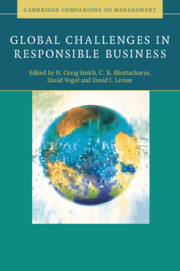Book contents
- Frontmatter
- Contents
- List of figures
- List of tables
- List of contributors
- Foreword
- Introduction: Corporate responsibility and global business
- Part I Embedding corporate responsibility
- Part II Marketing and corporate responsibility
- Part III Corporate responsibility and developing countries
- 8 Stretching corporate social responsibility upstream: improving sustainability in global supply chains
- 9 Breaking new ground: the emerging frontier of CSR in the extractive sector
- 10 Overcoming rural distribution challenges at the bottom of the pyramid
- Index
10 - Overcoming rural distribution challenges at the bottom of the pyramid
Published online by Cambridge University Press: 05 June 2012
- Frontmatter
- Contents
- List of figures
- List of tables
- List of contributors
- Foreword
- Introduction: Corporate responsibility and global business
- Part I Embedding corporate responsibility
- Part II Marketing and corporate responsibility
- Part III Corporate responsibility and developing countries
- 8 Stretching corporate social responsibility upstream: improving sustainability in global supply chains
- 9 Breaking new ground: the emerging frontier of CSR in the extractive sector
- 10 Overcoming rural distribution challenges at the bottom of the pyramid
- Index
Summary
Les bons pauvres ne savant pas que leur office est d'exercer notre générosité.
Introduction
Recent thinking and practice in management has challenged the widely held view that the role of the poor, as Sartre put it, is to exercise our generosity. There are alternatives to charity where the poor help themselves and business plays a part by pursuing its economic interests and tapping the economic potential of the bottom of the pyramid (BOP) – the 2.7 billion people who live on less than $2 a day. Prahalad and Hammond, in their seminal article on ‘Serving the World's Poor, Profitably’, highlighted the potential of market forces in large-scale poverty alleviation: ‘By stimulating commerce and development at the bottom of the economic pyramid, MNCs could radically improve the lives of billions of people and help bring into being a more stable, less dangerous world.’
This was a particularly welcome message in light of the challenges of meeting the Millennium Development Goals and concern about the role of poverty in fostering terrorism. A literature has since developed that builds on the core argument of Prahalad and his colleagues. However, while multiple case studies have provided further support for the idea of ‘a fortune at the bottom of the pyramid’, less attention has been given to the specific strategies and business models required. In this chapter, we focus on distribution strategies for reaching the rural poor – the majority of the BOP that poses distinct distribution challenges relative to the urban poor, who in many respects are easier to reach.
- Type
- Chapter
- Information
- Global Challenges in Responsible Business , pp. 268 - 302Publisher: Cambridge University PressPrint publication year: 2010

